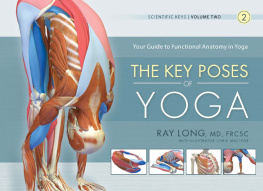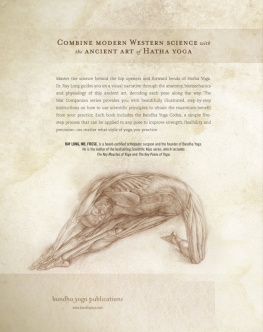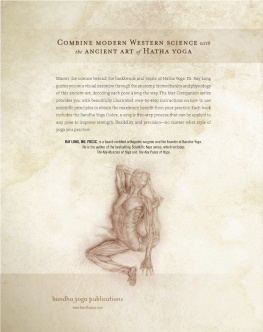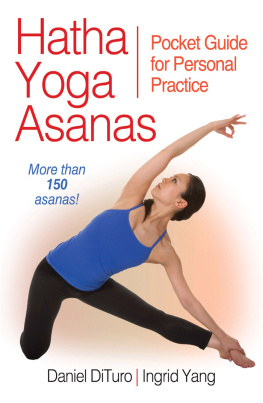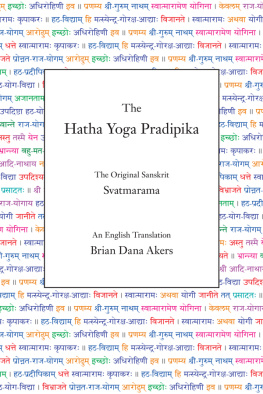
On a given day, a given circumstance, you think you have a limit. And you then go for this limit and you touch this limit, and you think, Okay, this is the limit. As soon as you touch this limit, something happens and you suddenly can go a little bit further. With your mind power, your determination, your instinct, and the experience as well, you can fly very high.
Ayrton Senna
Written by Raymond A. Long, MD, FRCSC; Illustrated by Chris Macivor
Design: Chris Cantley
Ten Bull Pictures Illustrated by Alana McCarthy
Editorial Services: Anne McDonell, Eileen Wolfberg
Proofreader: Eryn Kirkwood, MA
Copyright 2008, Raymond A Long, MD, FRCSC
ISBN 13: 978-1-60743-239-5
Bandha Yoga Publications LLC
All rights reserved. No part of this publication may be reproduced or transmitted in any other form or by any means, electronic or mechanical including photocopy, recording, or any information storage and retrieval system now known or to be invented, without permission in writing from the publisher, except by a review written for inclusion in a magazine, newspaper, or broadcast.
Attention: Disclaimer
Always, in your particular case, consult your health care provider and obtain full medical clearance before practicing yoga or any other exercise program. The information provided in this book, related blog, website, and other material (information) is strictly for reference purpose only. This information is not a substitute for medical advice and is not to be used in any manner for the diagnosis and/or treatment of any medical or surgical condition. If you suspect you have a medical problem, consult your physician. The information provided herein is also not to be used in any manner as a substitute for the direct guidance of a qualified yoga instructor. Always practice yoga and other exercise programs under the direct supervision and guidance of a qualified instructor. Practicing under the direct supervision and guidance of a qualified instructor can, but is not guaranteed to, help avoid injuries. Not all yoga or other exercise practices are appropriate or suited for every person. Practice yoga and other exercise programs at your own risk. The publisher, author, editor, illustrator, and distributor collectively and severally disclaim any liabilities and assume no responsibility for injuries or any other loss that may result from practicing yoga or any other exercise program. The publisher, author, editor, illustrator, and distributor collectively and severally disclaim any liabilities of loss or injury in connection with any information provided in this book, related blog, website, and/or other material. The publisher, author, editor, illustrator, and distributor all make no representations or warranties with regards to the completeness or accuracy of this book, related website, any linked websites, DVDs, or other products represented herein.
Printed in China
11 12 13 14 15 10 9 8 7 6 5 4 3
About the Author
Ray Long, MD, FRCSC, is a board certified orthopedic surgeon and the author of The Key Muscles of Hatha Yoga. Ray graduated from The University of Michigan Medical School with post-graduate training at Cornell University, McGill University, The University of Montreal, and Florida Orthopedic Institute. Ray has studied Hatha Yoga for over 20 years, travelling to India on numerous occasions to study extensively with B.K.S. Iyengar and other leading Yoga masters.
About the Illustrator
Chris Macivor has been involved in the field of digital content creation for well over 10 years. He is a graduate of Etobicoke School of the Arts, Sheridan College, and Seneca College. Chris considers himself to be equally artistic and technical in nature. As such, his work has spanned many genres from film and television to videogames and underwater imagery. Working with Dr. Long on the Scientific Keys book series, he has endeavored to digitally reproduce the biomechanical perfection of the human body. With a keen eye for subtle lighting and a passion to strive for excellence in his art, Chris constantly seeks to bring his imagery to life.
Table of Contents
Introduction

Figure 1: The biceps and brachialis are synergists of elbow flexion. The triceps, as elbow extensors, are antagonists of elbow flexion.
My first spiritual teacher, author and mystic Robert A. Johnson, taught me to look at what is. He was speaking about life in general, and his advice applies to the practice of Hatha Yoga as well.
Throughout our first book in this series, The Key Muscles of Hatha Yoga, we illustrate the relationship between form and function for the bones, joints, ligaments, and muscles. Similarly, looking at the form or shape of any given Yoga pose reveals its unique function.
Individual joints have a number of specific muscles that create movement. Look at to see how activating the biceps and brachialis muscles flexes the elbow and lengthens the muscles that oppose this actionthose at the back of the upper arm, the triceps.
Individual Yoga poses have specific groups of muscles that work together to create optimal form. I call these muscle groups the synergists of the pose. You can deepen and stabilize a pose by activating these muscles.
Look at to see this concept in action with the standing pose Prasarita Padottanasana. This image illustrates how contracting the muscles at the front of the thigh, hip, and torsothe quadriceps, psoas, and rectus abdominisdeepens the pose and stretches the opposing muscles at the back of the thigh and buttocks and along the spine. This is how combining the synergists in a Yoga pose creates the optimal functional benefit for the practitioner.

Figure 2: The synergists (blue) and antagonists (red) in Prasarita Padottanasana.
Yoga poses are like keys that unlock our conscious awareness of the body. Forward bends stretch and release the structures on the back of the body, while strengthening the muscles on the front of the body. Back bends have an opposite effect, and so on for the different categories of poses. Knowledge of the functional anatomy of Yoga reveals the mechanisms behind these processes.
The Key Poses of Hatha Yoga is intended to be a visual reference for the practitioner to aid in his or her individual journey. It illustrates 55 of the fundamental poses of Hatha Yoga, the suggested positions of the major joints and muscles that contract to create these key positions, as well as the muscles that stretch in the various poses. Part One of The Key Poses of Hatha Yoga illustrates the science behind the biomechanics and physiology of stretching muscles. Part Two applies this knowledge to the various categories of poses to unlock the benefits.
Practicing Yoga is an exploration of our individual bodies. Bear in mind that there are many interpretations of the poses. There are also variations for the postures, depending on the system of Hatha Yoga and the experience of the practitioner. Enjoy your practice and seek out your own best interpretations. Find out what works for you in opening the door to your individual experience of Yoga.
Namast
Ray Long, MD, FRCSC
How To Use This Book

Next page
